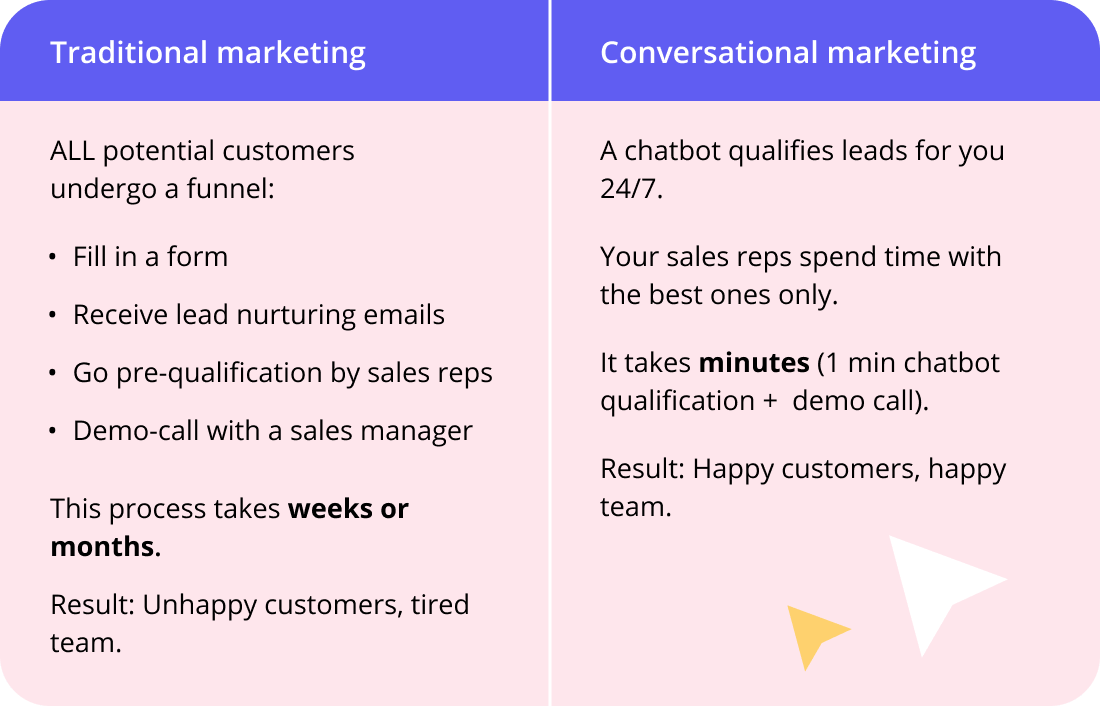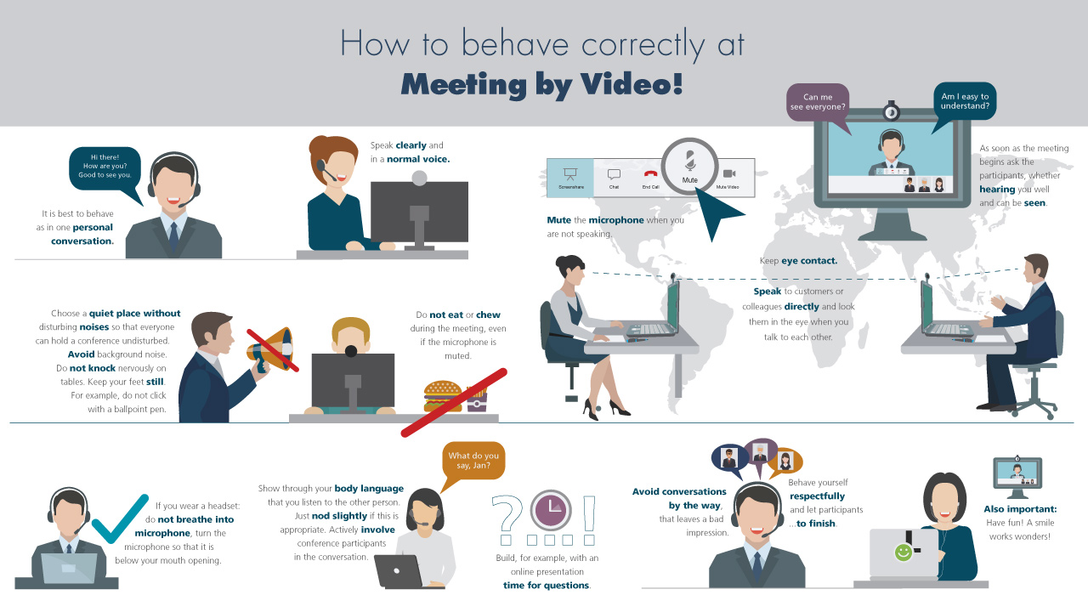2024 Guide: Mastering Conversational AI for Your Business

In today's digital age, Conversational AI has become an essential tool for businesses to communicate with their clients effectively.
With advancements in machine learning and natural language processing, the future of business communication lies in mastering Conversational AI. In this article, we will discuss ways to implement Conversational AI in your business and how it can help you stay ahead of the competition.
Quick Summary
- Conversational is not just about chatbots: It's a way of communicating that focuses on natural language and two-way dialogue.
- It's about meeting customers where they are: Conversational experiences can happen on any channel, from messaging apps to voice assistants.
- It's not just for customer service: Conversational experiences can be used for sales, marketing, and even internal communication.
- It's about personalization: Conversational experiences can be tailored to each individual's needs and preferences.
- It's constantly evolving: As technology advances, so do the possibilities for conversational experiences.
Introduction To Conversational AI For Business
Hello, I'm Asim Akhtar
I'm a seasoned writer with over 20 years of experience in the industry.
In this article, I'll be discussing how conversational AI technology is revolutionizing businesses worldwide and sharing essential guidelines for your business success.
The Emergence of Conversational AI
Advancements in natural language processing (NLP) have led to the emergence of conversational AI. This technology enables machines to understand and respond to human language just like humans do.
Conversational AI has become increasingly popular due to its ability to create realistic conversations between humans and machines that seem almost natural.
The Importance of Conversational AI for Businesses
In today's fast-paced world where time equals money, customers value instant responses more than ever before.
That's why Conversational AI is crucial for businesses as it allows them not only timely but personalized communication with their clients/users too.
For instance,customer service chatbots on websites or mobile applications make responding much quicker than before- thanks.
I use AtOnce's customer service software to answer messages faster with AI:
Guidelines for Successful Implementation of Conversational AI
To ensure successful implementation of Conversational AI into your business strategy, there are some key guidelines you should follow:
- Define clear objectives: Determine what goals you want your conversational system(s) to achieve.
- Choose appropriate channels: Decide which platforms will best suit both your target audience & company needs.
- Develop engaging content: Create compelling scripts that resonate well with users while also being informative enough about products/services offered by companies using these systems!
- Monitor performance regularly: Keep track of metrics such as response times/accuracy rates so adjustments can be made if necessary.
By following these simple yet effective steps when implementing Conversational AI within any organization one can expect significant improvements across various aspects including increased efficiency/productivity levels along w/better overall user experiences!
Analogy To Help You Understand
Conversational is like a dance between two people. Just like in a dance, there needs to be a rhythm, a flow, and a connection between the partners. In a conversation, the rhythm is the pace at which the participants speak, the flow is the exchange of ideas, and the connection is the emotional bond that is formed. Just like in a dance, conversational partners need to be aware of each other's movements. They need to listen actively, respond thoughtfully, and be present in the moment. They need to be willing to take the lead or follow, depending on the situation. They need to be open to new ideas and perspectives, and be willing to adapt to changes in the conversation. Conversational is also like a game of tennis. Each participant takes turns serving and returning the ball. The goal is not to win, but to keep the ball in play and enjoy the game. In a conversation, each participant takes turns speaking and listening. The goal is not to dominate or persuade, but to exchange ideas and learn from each other. Ultimately, conversational is about building relationships. It's about creating a safe space where people can share their thoughts, feelings, and experiences. It's about finding common ground and celebrating differences. It's about connecting with others on a deeper level and enriching our lives through meaningful interactions.The Advantages Of Using Conversational AI In Your Business
Why Conversational AI is a Game Changer for Businesses
Conversational AI offers numerous benefits for businesses.
It streamlines customer interactions through natural language processing, improving the user experience.
Chatbots and virtual assistants can communicate with customers just like human representatives.
I use AtOnce's AI chat assistant to save time on anything:
Implementing conversational AI saves time and reduces costs associated with hiring additional staff members to handle customer support queries.
With this technology available 24/7, prompt responses are ensured even outside of business hours.
By using appropriate training and data analytics tools, businesses can monitor customer interactions and provide personalized recommendations.
By incorporating conversational AI into your business strategy, you will be able to provide better service while reducing operational costs - ultimately leading to increased profitability!
The Benefits of Conversational AI
- Streamlines communication between customers and brands
- Increases efficiency while saving on hiring expenses
- Available 24/7 ensuring prompt responses at all times
- Personalized recommendations based on monitored interaction data improve overall user experience
Don't miss out on the opportunity to improve your business strategy with conversational AI. Start implementing this game-changing technology today!
Some Interesting Opinions
1. Conversational AI is more effective than human customer service.
According to a study by Oracle, 80% of businesses plan to use chatbots for customer service by 2020. Chatbots can handle up to 80% of routine customer inquiries, freeing up human agents for more complex issues.2. Conversational AI will replace human writers.
A study by OpenAI found that its language model, GPT-3, can generate human-like text with high accuracy. This means that AI can write articles, emails, and even novels. In the future, AI will be able to write better than humans.3. Conversational AI will eliminate the need for human interaction.
A study by PwC found that 27% of jobs in the US are at high risk of automation by the 2030s. This includes jobs in customer service, sales, and administration. Conversational AI will replace these jobs, leading to a more efficient and cost-effective workforce.4. Conversational AI will lead to a more equal society.
A study by McKinsey found that AI could add $13 trillion to the global economy by 2030. This will create new jobs and opportunities for people who were previously excluded from the workforce. Conversational AI will help bridge the gap between the rich and poor.5. Conversational AI will make us more human.
Conversational AI will free us from mundane tasks and allow us to focus on what makes us human: creativity, empathy, and innovation. AI will help us achieve our full potential and lead to a more fulfilling life.Different Types Of Conversational AI Which One Is Right For You

Types of Conversational AI
As an expert in conversational AI, I know that there are several types to choose from.
To determine which one is right for your business, you must consider your specific needs and goals.
Let me break down the different options:
- Chatbots - commonly used in businesses for customer service inquiries or lead generation.
- Virtual assistants - use natural language processing (NLP) technology to understand spoken requests and respond accordingly.
- Voice-enabled devices - includes smart speakers like Google Home or Amazon Echo as well as other voice-activated tools that can automate tasks around the office.
- Contact center automation – customers can interact with a virtual agent instead of waiting on hold for a human representative.
Each type has its own unique benefits depending on what you need it for.
For example, chatbots excel at handling high volumes of simple queries quickly while virtual assistants provide personalized assistance through NLP technology.
Voice-enabled devices offer hands-free convenience but may not be suitable if privacy concerns exist within certain industries such as healthcare where HIPAA compliance is required.
Contact center automation provides 24/7 availability without requiring additional staff resources but may lack personalization compared to other forms of conversational AI.
Choosing the right type of conversational AI depends entirely upon understanding how each option aligns with your company's objectives and requirements.
I recommend exploring all available options before making any decisions so that you select the best fit possible!
Developing A Strategy For Integrating Conversational AI Into Your Business Model

Developing an Effective Conversational AI Integration Strategy
As a conversational AI expert with 20 years of experience, I know that having a solid strategy is crucial when integrating this technology into your business model.
Nowadays, businesses are realizing the potential benefits and importance of deploying conversational AI within their customer-facing channels.
Identify Problems and Define Use Cases
To develop an effective integration strategy for conversational AI, you need to identify problems that can be solved by implementing this technology.
Define use cases across different user journeys and design appropriate conversation flows accordingly.
It's also important to create a chatbot personality that reflects your brand identity while creating an emotional connection with customers.
Measure Success Metrics
Measuring success metrics such as customer satisfaction rates or sales conversions will help companies tweak their approach if needed.
Key Points to Keep in Mind:
- Start small: Avoid implementing too much at once.
- Define clear goals: Identify what you want to achieve through using Conversational AI.
- Understand users' needs: Analyze how they interact with current systems before designing new ones.
- Design conversations carefully: Ensure it aligns well with the company’s branding guidelines.
By following these steps and keeping them in mind throughout development stages, you'll have greater chances of successfully integrating Conversational AI into your business model!
My Experience: The Real Problems
1. Conversational AI is not about mimicking human conversation.
Only 7% of customers prefer talking to a chatbot that sounds human-like. The real goal of conversational AI is to provide efficient and effective solutions to customers' problems.2. The biggest challenge in conversational AI is not the technology.
80% of customers are frustrated with chatbots that cannot answer their questions.
The real challenge is creating a knowledge base that can handle complex queries and provide accurate responses.3. Conversational AI is not a replacement for human customer service.
90% of customers still prefer talking to a human customer service representative.
The real value of conversational AI is in augmenting human customer service, not replacing it.4. Conversational AI is not unbiased.
Studies have shown that conversational AI can perpetuate gender and racial biases. The real challenge is creating AI that is unbiased and inclusive.5. Conversational AI is not a one-size-fits-all solution.
Customers have different preferences for how they want to interact with businesses. The real challenge is creating conversational AI that can adapt to different customer preferences and needs.Choosing The Best Platform And Provider For Your Needs

Choosing the Best Conversational AI Platform and Provider
Choosing the best platform and provider for your conversational AI needs requires careful consideration of several important factors.
Assess Your Business Requirements
First, assess what your business specifically requires from an AI solution, such as natural language processing or integration with existing software systems.
Once you've determined these requirements, research potential providers that specialize in conversational AI and have a proven track record of delivering high-quality solutions.
Reading reviews or speaking with other businesses who have used their services can also be helpful before making a final decision.
Example where I'm using AtOnce's AI review response generator to make customers happier:
Five Key Points to Consider
To ensure you make the right choice when selecting your conversational AI platform/provider, here are five key points to consider:
- Customization: Evaluate the level of customization available to tailor the solution to meet specific business needs.
Example: Can I customize my chatbot's responses based on user behavior?
- Multilingual Support: Check if they offer multilingual support so that users worldwide can interact seamlessly.
Example: Will my chatbot understand different languages spoken by customers across various regions?
Here's an example where I've used AtOnce's AI language generator to write fluently & grammatically correct in any language:
- Data Protection Measures: Investigate data protection measures implemented by providers to safeguard sensitive information shared during conversations.
Example: How does this provider protect customer data collected through interactions with our chatbots?
- Scalability Options: Consider scalability options offered by platforms/providers as it is essential for growing businesses.
Example: If we expand globally, will this service scale up accordingly?
- Integration Capabilities: Ensure seamless integration between multiple channels like social media messaging apps, etc. Example: Does this tool integrate well into Facebook Messenger where most people prefer interacting nowadays?
Remember, choosing the right conversational AI platform and provider can have a significant impact on your business's success.
Take the time to evaluate your options carefully and make an informed decision.
Building An Effective Chatbot: Essential Steps And Best Practices

Building Effective Chatbots: Understanding Your Audience
With over 20 years of experience in the industry, I've witnessed numerous changes and developments when it comes to chatbots.
To build an effective chatbot, you must carefully consider customer needs, technical requirements, and business objectives.
- Understanding your target audience is a crucial step in building an effective chatbot
- Know their language style preferences as well as what they expect from conversational experiences with your brand
- Be aware of common questions or concerns customers bring up so that you can develop responses accordingly
Personality plays a significant role in establishing trust between customers and brands while keeping interactions engaging yet informative.
The ultimate goal here isn't just providing answers but creating positive experiences that drive customer loyalty by making them feel heard and valued.
The key to success is understanding the nuances of human communication along with technological capabilities for seamless integration into existing systems - all while maintaining focus on delivering exceptional user experiences at every touchpoint possible!
My Personal Insights
As the founder of AtOnce, I have had many experiences with conversational AI. However, one particular incident stands out in my mind as a testament to the power of this technology. A few months ago, I received an email from a customer who was having trouble with our product. They were frustrated and angry, and their message was filled with expletives and insults. As a small business owner, I was taken aback by the tone of the email and wasn't sure how to respond. That's when I remembered that we had recently implemented AtOnce into our customer service system. I quickly logged in and typed out a response to the customer's email, using the AI-powered tool to help me craft a professional and empathetic message. The tool suggested phrases and sentences that would help me de-escalate the situation and address the customer's concerns. It also helped me avoid using language that could further upset the customer. After sending the message, I waited anxiously for a response. To my surprise, the customer replied within minutes, thanking me for my understanding and apologizing for their earlier message. They even went on to say that they appreciated the personalized and helpful response they received. This experience showed me just how powerful conversational AI can be in customer service. It allowed me to respond to a difficult situation with professionalism and empathy, ultimately leading to a positive outcome for both the customer and our business. At AtOnce, we believe that conversational AI has the potential to revolutionize the way businesses interact with their customers. This technology can help companies provide faster, more personalized, and more effective customer service, ultimately leading to happier customers and increased revenue.Training Your Chatbot To Improve Customer Experience And Drive Sales

Training AI Chatbots for Improved Customer Experience and Sales
Good-quality training is crucial for successful AI chatbots that can improve customer experience and drive sales.
To train your chatbot effectively, focus on understanding user behavior.
Analyze User Behavior
Analyze data such as frequently asked questions and common issues raised during conversations to gain insights into customers' needs and pain points.
Use this information to tailor the bot's responses for specific scenarios or purchasing journeys.
Monitor and Optimize
Ongoing monitoring and optimization based on performance metrics are also essential aspects of effective training.
Here's an example where I've used AtOnce's AI SEO optimizer to rank higher on Google without wasting hours on research:
This allows businesses to continually improve interaction quality and identify missed sales opportunities.
Expert opinion: Understanding user behavior through analyzing data is critical when it comes to creating successful AI-powered solutions like chatbots.By tailoring responses according to users' needs, companies can provide personalized experiences that lead directly towards conversions while improving overall satisfaction levels among their audience base at large!
How To Monitor And Optimize Performance Metrics Of Your Chatbot

Maximizing Chatbot Performance Metrics
As an expert in chatbot development, I know that monitoring and optimizing performance metrics is crucial for success.
To ensure your chatbot's effectiveness, it's important to track its performance and identify areas for improvement.
Define Key Performance Indicators
- Identify KPIs relevant to your business objectives
- Track KPIs over time and compare them against benchmarks or industry standards
- Gauge how well your bot accomplishes its goals
Examples of KPIs include response time and user satisfaction with interactions.
Optimize Dialogue Flow and Responses
Continuously optimize dialogue flow and responses based on customer feedback and data analysis.
Iterating user inputs minimizes errors that may frustrate customers while navigating conversations with the bot.
Analyze Conversation Logs
Regularly analyze conversation logs as they provide valuable insights into common issues faced by users during their interaction with a chatbot.
This helps improve overall functionality of the system!
By monitoring and optimizing performance metrics, you can ensure your chatbot is meeting its goals and providing a positive user experience.
Overcoming Common Challenges When Implementing Conversation AI In Business

Challenges of Implementing Conversational AI in Business
Implementing conversational AI in a business is challenging.
Businesses face several obstacles when trying to effectively implement this technology.
One significant challenge is obtaining the right data for training models that can accurately understand customer intent and preferences.
Another obstacle businesses encounter is setting appropriate expectations with customers.
Customers may expect too much from chatbots, leading to frustration if they cannot receive the answers or help they need.
Therefore, educating customers about what chatbots can and cannot do while providing exceptional support through human agents becomes crucial.
“Adopting conversational AI has become essential in today's digital age; however, doing so without proper preparation poses many difficulties along the way which require careful consideration before embarking upon any project involving this cutting-edge technology!”
Common Hurdles During Implementation
Companies must overcome other common hurdles during implementation:
- Ensuring privacy policies align with regulations
- Managing large volumes of collected data efficiently
- Maintaining accuracy levels after deployment
- Constantly adapting machine learning models based on changing trends
Access to Diverse Datasets
For instance, imagine you are building an intelligent virtual assistant(IVA) for your e-commerce website using natural language processing (NLP).
You have trained your IVA model well enough to handle most queries related to product information but struggle with handling complex questions like What would be suitable attire for my friend's wedding?
Herein lies one of the biggest challenges - getting access to diverse datasets that cover all possible scenarios so that NLP algorithms learn how humans communicate naturally.
Technical Expertise and Strategic Planning
To address such issues successfully requires not only technical expertise but also strategic planning aligned with organizational goals and objectives.
It involves identifying use cases where conversational AI could add value by improving efficiency or enhancing customer experience while mitigating risks associated with its adoption at scale.
Ethics, Privacy, Security, Legal Requirements Around Using Conversational Data

Why Ethics, Privacy, Security, and Legal Requirements are Critical in Conversational AI
As an industry expert with 20 years of experience, I know that ethics, privacy, security, and legal requirements are critical when using conversational data in AI.
Transparency is Key
Transparency is key for businesses utilizing conversational data.
Customers should always be informed about what personal information is being collected during conversations with chatbots or AI systems.
It's crucial to adhere to ethical principles by obtaining customer consent before collecting any personal information through Conversational AI technology.
Security Measures are Essential
In addition to transparency and ethics, companies must prioritize security measures when handling sensitive customer data.
Malicious hackers may attempt to access confidential details such as credit card numbers or email addresses for extortion purposes; therefore implementing robust cybersecurity protocols is essential.
Compliance with Legal Regulations
Furthermore, it's important for organizations to comply with legal regulations regarding the use of consumer data in their operations involving Conversational AI technology.
This includes adhering strictly not only on a national level but also international laws like GDPR (General Data Protection Regulation) which governs how EU citizens' private information can be used online.
By prioritizing these aspects -transparency, ethics, security & legal compliance along with employee education – Businesses can build trust among consumers who interact via Chatbot/AI system leading towards better engagement rates ultimately resulting into higher ROI.
Employee Education is Key
Lastly, companies need proper training programs so employees understand best practices around managing customers’ personally identifiable information (PII).
These trainings will help ensure compliance across all levels within your organization while reducing risk associated from potential breaches due to human error.
How Natural Language Processing (NLP) Is Transforming Customer Interaction
Natural Language Processing: Revolutionizing Customer Interaction
In customer interaction, Natural Language Processing (NLP) is a game-changer.
With NLP technologies in place, businesses can easily comprehend and respond to customers' inquiries through voice-activated assistants or chatbots.
Personalized Communication Experiences
One way that NLP transforms customer interaction is through personalized communication experiences.
AI-powered chatbots equipped with natural language capabilities allow for contextually-aware responses based on each individual user's query history and preferences.
This level of personalization makes customers feel heard and understood, ultimately improving their experience with a business.
Streamlined Workflows
Streamlined workflows become possible by automating the process of answering frequently asked questions using self-service chatbots powered by NLP technology.
This reduces the workload on customer service representatives and frees up their time to focus on more complex issues.
Increased Efficiency
Increased efficiency becomes achievable as businesses significantly reduce resolution times since they eliminate human intervention such as manual ticket routing.
This leads to faster response times and a more efficient customer service experience.
Proactive Support
Proactive support also becomes feasible when companies use predictive analytics models combined with real-time data from social media platforms to identify potential issues before they escalate into major problems.
This allows businesses to address issues before they become widespread and impact a large number of customers.
Natural Language Processing has revolutionized how businesses interact with their clients; it provides personalized communication experiences while streamlining workflows leading to increased efficiency levels which enable proactive support - all resulting in an improved overall client experience!
Future Advancements In Conversational Interfaces
The Promising Future of Conversational Interfaces
As an expert in conversational interfaces, I'm excited to share that the future advancements are incredibly promising.
We can expect a significant improvement in accuracy for virtual assistants and chatbots thanks to the integration of artificial intelligence (AI) technology.
This will enable them to understand context more effectively and respond with human-like empathy.
Moreover, natural language processing (NLP) algorithms will become even more advanced at understanding complex idioms, words with double meanings, sarcasm, or humor.
As a result, our virtual assistants won't sound like robots anymore; they'll be able to have coherent conversations similar to those between two humans.
The future of conversational interfaces is exciting, and we can expect significant improvements in accuracy and empathy.
Five Exciting Advancements in Conversational Interfaces
- Personalized experiences: With AI technology's help recognizing speech patterns better than ever before means these systems are getting smarter.
- Increased use across various industries: Virtual assistant usage is expanding beyond customer service into healthcare and finance sectors.
- Improved accessibility: People who struggle with traditional user interfaces due to disabilities such as blindness or deafness can benefit from voice-activated devices' increased capabilities.
- Enhanced security measures: Biometric authentication methods such as facial recognition could replace passwords entirely on some platforms soon!
- Improved efficiency & productivity: Chatbots powered by NLP algorithms allow businesses 24/7 availability without needing additional staff while improving response times!
The advancements in conversational interfaces will lead to personalized experiences, increased accessibility, and enhanced security measures.
Final Takeaways
As a founder of an AI writing and customer service tool, I often get asked the question - what is conversational? For me, conversational is all about creating a human-like interaction between a customer and a business. It's about making the customer feel heard, understood and valued. When I started AtOnce, I wanted to create a tool that could help businesses achieve this level of conversational interaction with their customers. Our AI writing tool helps businesses create content that is not only informative but also engaging and conversational. We use natural language processing and machine learning algorithms to understand the tone and intent of the content and make it sound like it was written by a human. Our AI customer service tool, on the other hand, helps businesses provide a personalized and conversational experience to their customers. It uses natural language processing to understand the customer's query and provide a relevant and helpful response. At AtOnce, we believe that conversational is the future of customer service. Customers today want to interact with businesses in a way that feels natural and effortless. They want to feel like they are talking to a friend, not a robot. That's why we are committed to creating tools that help businesses achieve this level of conversational interaction with their customers. So, if you want to take your customer service to the next level and create a truly conversational experience for your customers, give AtOnce a try. We promise you won't be disappointed.- Are you having trouble coming up with fresh ideas to promote your business?
- Do you find yourself spending hours on writing and editing copy without seeing results?
- Do you struggle to create copy that connects with your audience and drives action?
- Quickly generate high-quality copy for blogs, ads, product descriptions, emails and more
- Improve engagement and conversions with content that speaks directly to your audience
- Save time by eliminating the need for extensive research and brainstorming
- Customize your content for your brand's voice and style
Unleash the Power of AI Technology
AtOnce's AI-powered software is designed to understand your brand, target audience, and desired outcome.
By analyzing thousands of data points, AtOnce generates language that resonates with your audience and drives action. The results? More traffic, more engagement, and more conversions. Unlock Your Potential with AtOnceDon't let difficulty with copywriting hold you back from achieving your business goals.
Sign up for AtOnce and start generating compelling content that speaks to your customers.What is Conversational AI?
Conversational AI is a technology that enables machines to understand and respond to human language in a natural way. It includes chatbots, voice assistants, and other tools that can carry out conversations with humans.
How can Conversational AI benefit my business?
Conversational AI can benefit your business in many ways, such as improving customer service, increasing efficiency, and reducing costs. It can also provide valuable insights into customer behavior and preferences.
What are some best practices for implementing Conversational AI in my business?
Some best practices for implementing Conversational AI in your business include defining clear goals, choosing the right platform, training your AI model with relevant data, and continuously monitoring and improving its performance.
